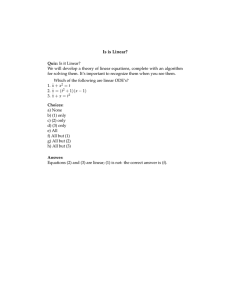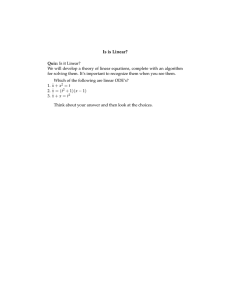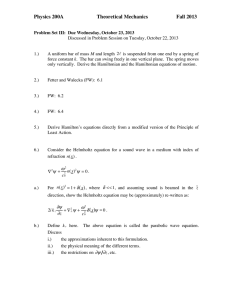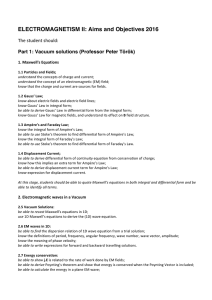12.802 Problem Set 3 Spring 2008
advertisement
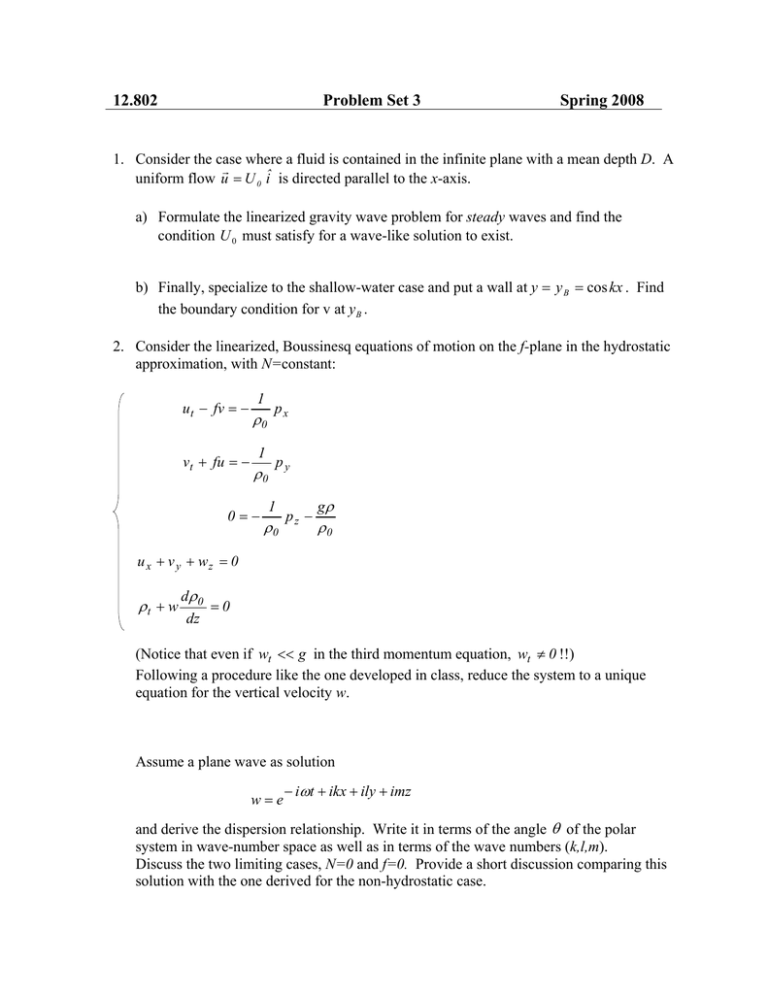
12.802 Problem Set 3 Spring 2008 1. Consider the case where a fluid is contained in the infinite plane with a mean depth D. A r uniform flow u = U 0 î is directed parallel to the x-axis. a) Formulate the linearized gravity wave problem for steady waves and find the condition U 0 must satisfy for a wave-like solution to exist. b) Finally, specialize to the shallow-water case and put a wall at y = y B = cos kx . Find the boundary condition for v at yB . 2. Consider the linearized, Boussinesq equations of motion on the f-plane in the hydrostatic approximation, with N=constant: u t − fv = − vt + fu = − 1 ρ0 1 ρ0 0=− px py 1 ρ0 pz − gρ ρ0 u x + v y + wz = 0 ρt + w dρ 0 =0 dz (Notice that even if wt << g in the third momentum equation, wt ≠ 0 !!) Following a procedure like the one developed in class, reduce the system to a unique equation for the vertical velocity w. Assume a plane wave as solution w=e − iωt + ikx + ily + imz and derive the dispersion relationship. Write it in terms of the angle θ of the polar system in wave-number space as well as in terms of the wave numbers (k,l,m). Discuss the two limiting cases, N=0 and f=0. Provide a short discussion comparing this solution with the one derived for the non-hydrostatic case. 3. Consider the case of a non-rotating stratified but compressible fluid for which the Boussinesq approximation does not hold. The momentum and mass conservation equations are still du * 1 ∂p* =− * dt ρ ∂x (1) dv * 1 ∂p* =− * dt ρ ∂y (2) dw * 1 ∂p* =− * -g dt ρ ∂z (3) ( ) r ∂ρ * + ∇ • ρ* u* = 0 ∂t (4) but the energy equation is now: dρ * 1 dp* = dt c s2 dt (5) where c is the sound speed. s Assume as previously u * = u0 + u ≡ u p * = p0 ( z ) + p ρ * = ρ0 ( z ) + ρ where the basic state is at rest ( u0 ≡ 0 ) and is in hydrostatic equilibrium. a) Transform eq. (4) in such a way as to use eq. (5) for equation (4). dρ * . This will be the new dt b) Linearize all the equations of motion, remembering that the Brünt-Vaisala frequency is now: N 2( z ) = − dρ 0 g2 . − 2 ρ dz c 0 s g c) Equations (1), (2), (3) will be analogous to those derived in class for the incompressible case. Equations (4) and (5) will be different, containing terms involving the sound speed, c . Derive again for the entire set two equations in (w,p). s d) In the two equations obtained for (w,p), assume the coefficients to be constant and the time dependence of e − iωt , which will allow you to derive in a simple way a final equation for p, by eliminating w. e) In the p-equation assume a sinusoidal wave as a solution. Derive the dispersion relationship. What is its limit when c → ∞ ? s f) Optional: as the surfaces of constant ω are surfaces of revolution around the m-axis, expressing m=m( ω ), find the projections of the ω =constant surfaces in the ( m , k H ) ω ω plane in the two limits << 1 and >> 1 . N N MIT OpenCourseWare http://ocw.mit.edu 12.802 Wave Motion in the Ocean and the Atmosphere Spring 2008 For information about citing these materials or our Terms of Use, visit: http://ocw.mit.edu/terms.
